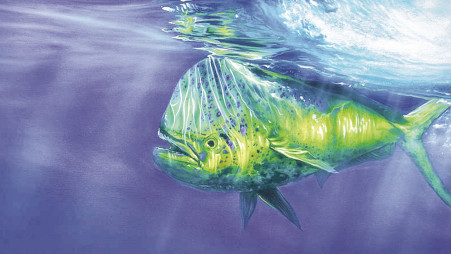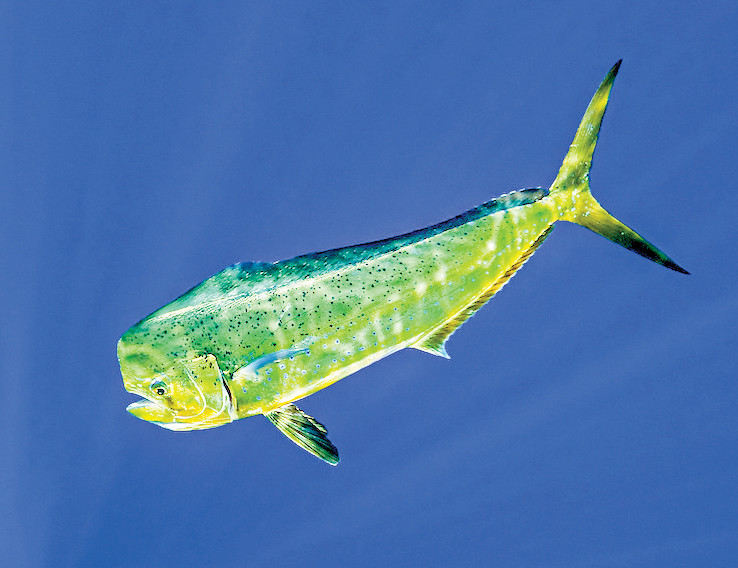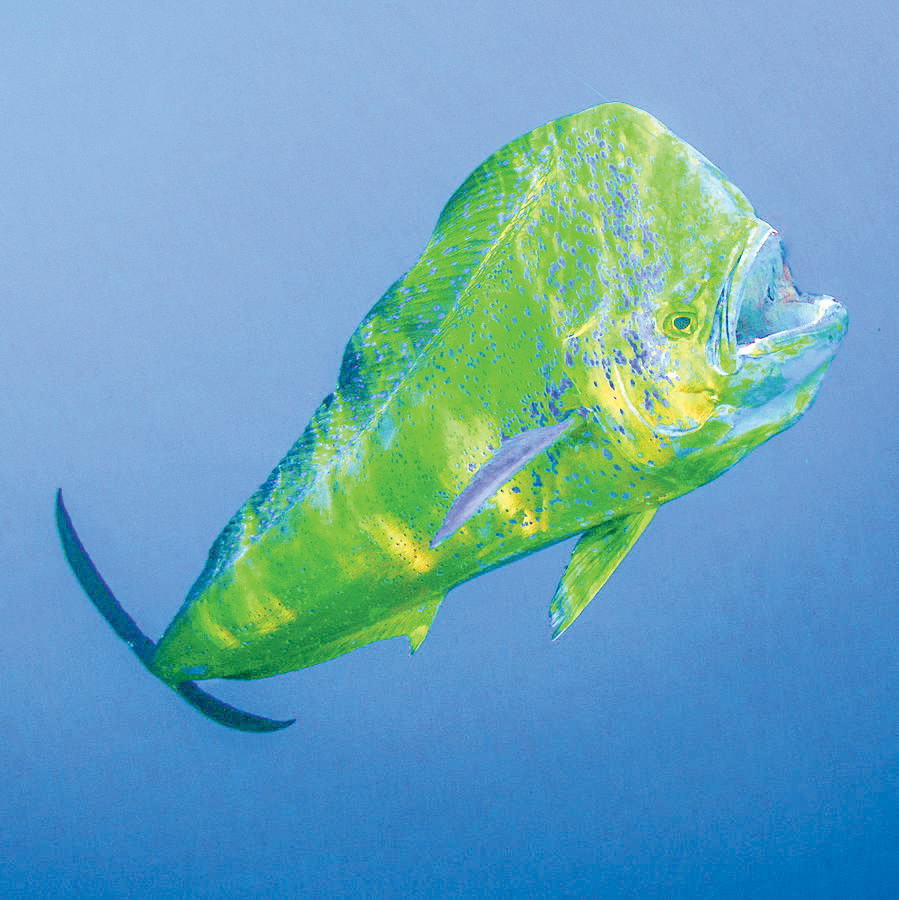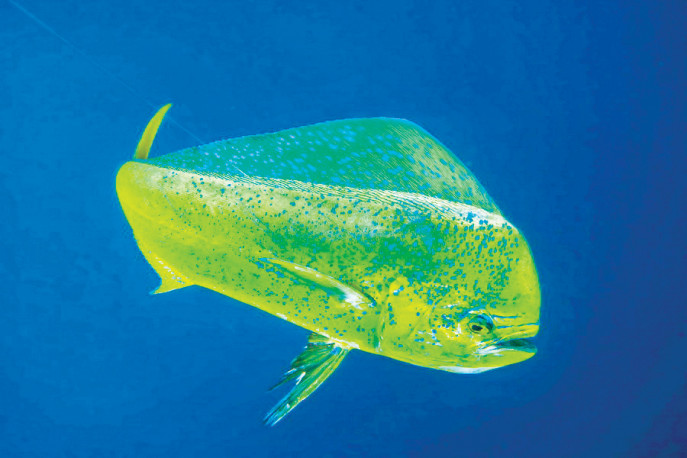On a fish named dolphin
The dolphinfish can reach speeds of 100 kilometres per hour and lives along the entire tropical belt – including in Bangladesh

I was going through my fieldnotes. In this time of global pandemic, we, wildlife biologists, are no exception. Keeping greater distance than usual and secluding oneself are not the issue. However, there is also an embargo on outdooring. Finding exceptional stories is hard – unbearable.
So, I looked into my journals, recalling memories and writing afresh. Typing, one particular anecdote drew my attention. It was from last January. I was on a trip to the Sundarbans. On the nearby Dublar Char, a mangrove isle jutted into the Bay of Bengal, I was intrigued watching an atypical fish. Though dressed and marinated, ready to be barbecued, the nuchal projection on its forehead was unmistakable. I saw it elsewhere along our coast. Yet, finding it there, beside a charcoal grill in the wintry dark deck of our vessel, elated me.

It was nearly a three-footer male common dolphinfish. Yes, you read the name right.
Soon afterwards, I dove deeper into my photo archives. The butterfly effect led me to identify another species of dolphinfish – pompano dolphinfish – a rarity in our bay. I came across it in Cox's Bazar in 2017. Deemed common, its story hid in a stack of folders.
If it was not for those mangrove moments, if I had not been stationary for a while, I could not have found the solace of a good story.
And, good stories become great when they are shared.
Today, dolphinfish will entertain you not by their taste, but instead, by their fabled beauty and character.
Why that name?
First things first, I must resolve your foremost query. Why on Earth should a fish be paired with a dolphin? Dolphins are mammals – lung-breathers. Fish are an entirely different class. Dolphinfish bear a similarity with dolphins though. They purportedly use high-pitched sonar to communicate, much like the sea-faring mammal. This fish also grows up to the size of a small dolphin. Other legends are associated with their Spanish name – dorado – which stands for golden. This adjective can describe both creatures.
If you do not want historic jargon, call them mahi mahi, a Hawaiian name and a popular one. It is nice when you call it twice.
Circumtropical and migratory

Dolphinfish are sleek and tapered – built for fast swimming abilities. The mohawk-like dorsal fin spans the entire back of the fish. It serves as a sail to manoeuvre quickly in the ocean. Not only do they swim very well, they rove a great distance each year. Scientists suspect they follow warm temperatures along the entire tropical belt, meaning you can find them in the Pacific, Atlantic and Indian oceans.
A great game

"The color of living dolphinfish can only be described as superbly beautiful. Detailed comments are never quite adequate to convey this impression." This description by Dr Bruce Collette from the National Marine Fisheries Service, US is no exaggeration. Mahi-mahi is not anything you might see at a landing centre, drab, discoloured and decomposing. Rather, to encounter the glaring beauty, you have to see a live one. In life, as you see in images, their colors are hard to describe. Always with a rich hue, these fish are turquoise, with blue-green as their base color, tinges of yellow on their flanks, flecked with contrasting with spots and patterns of azure blue.
Owing to their beauty, mohawked dorsal and strong-built dolphinfish are an angler's dream. All over the ranges they are highly sought after in sport fishing. They can grow up to be 30 kilogrammes and a hooked fish is flashy and acrobatic; can reach speeds of 50 knots – meaning 100 kilometres per hour!
Hard to find?

Now come to another point. Is finding a dolphinfish that easy? For our Bay of Bengal, yes. Bizarre it might seem, but it is true all the way. From many perspectives – you walk into a fish market or a fishing outpost you will see many which are never noted in our country's inventory. There are even species which could be entirely new to science; as we had, the Bengal Pufferfish Chelonodontops bengalensis in Dublar Char last year.
In the era of the Blue Economy, while the world is clinging to its oceans – flattening the diversity curve with monopolized monoculture – before it is too late, try your luck at finding exquisite fisheries resources.
From now on, whenever you are at a seaside fish market, do not just look for the tastiest fish. Set your sights on exquisite and exotics forms. The memories will be rewarding.

Into the life of the dolphinfish
Fastest-grower

Dolphinfish are one of the fastest-growing fishes in the ocean. However, they are short-lived with a maximum average lifespan of five years. These species are oceanic, predaceous, surface-dwellers, and visit mostly up to 200 metres deep. Dolphinfish often venture into shallow seas and reef zones.
Common and pompano

Between the two species, common dolphinfish Coryphaena hippurus is larger in all ways except for one. Pompano dolphinfish C. equiselis is less sleek – as the name implies – and less-studied. In coloration and appearance, both are the same. However, the bony hump on its forehead is not prominent in the lesser counterpart.
Good balance for the ecosystem

Being a predatory pelagic fish, dolphinfish are an important link in oceanic ecosystems. They help trim the population of sardines and minnows; in turn, are predated by large tuna, merlin and swordfish. Dolphinfish also have a common point with frigatebirds; together, they hunt in floating sargassum trails.
Their role in our Bay

Dolphinfish live in the Bay of Bengal, constructing a big part of pelagic predatory fish community. These fish eat sardines, triggerfish and smaller tunas. In turn, billfish like swordfish and marlins are regular predators of the dolphins. The smaller of the two, pompano dolphinfish is more oceanic and caught less. Frigatebirds are in constant pursuit of dolphinfish. Meaning, if there is a mahimahi nearby, frigatebirds are certainly behind, an ultra-rarity for country's ornithologists!



 Keep updated, follow The Business Standard's Google news channel
Keep updated, follow The Business Standard's Google news channel















